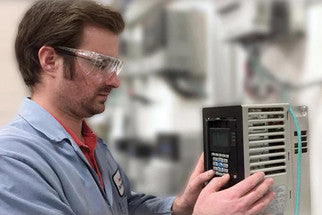
Variable Frequency Drives - VFDs
Variable frequency drives (VFDs) are electronic devices that are used to control the speed and torque of electric motors. They are commonly used in a wide range of applications, including HVAC systems, conveyor belts, pumps, and fans. In this blog post, we'll explore what VFDs are, how they work, and their benefits. What are Variable Frequency Drives? A variable frequency drive is an electronic device that controls the speed and torque of an AC motor by varying the frequency and voltage of the electrical supply to the motor. By changing the frequency and voltage, the VFD can adjust the speed and torque of the motor to meet the demands of the application. How do Variable Frequency Drives work? VFDs work by taking the incoming AC power supply and converting it to DC power using a rectifier. The DC power is then fed into an inverter, which converts it back into AC power at a variable frequency and voltage. The output of the inverter is then fed to the motor. The VFD is controlled by a microprocessor that monitors the motor's speed and torque and adjusts the frequency and voltage of the electrical supply to maintain the desired level of performance. This means that the motor can operate at its most efficient level, which can result in significant energy savings. Benefits of Variable Frequency Drives Energy savings One of the primary benefits of using VFDs is that they can significantly reduce energy consumption. By controlling the speed and torque of the motor, the VFD can ensure that the motor is operating at its most efficient level, which can result in energy savings of up to 50%. Improved control VFDs offer precise control over the speed and torque of the motor, which can be particularly useful in applications that require precise control. For example, in HVAC systems, VFDs can be used to adjust the speed of the fan based on the temperature and humidity levels in the building. Reduced wear and tear By controlling the speed and torque of the motor, VFDs can reduce the wear and tear on the motor, which can extend its lifespan and reduce the need for maintenance and repairs. Soft starting VFDs offer soft starting capabilities, which means that they can gradually ramp up the speed of the motor, rather than starting it at full speed immediately. This can reduce the stress on the motor and extend its lifespan. Reduced noise VFDs can reduce the noise levels in applications where motors are used, such as HVAC systems and fans. By controlling the speed of the motor, the VFD can reduce the noise generated by the motor. In conclusion, Variable Frequency Drives are powerful electronic devices that can significantly improve the performance and efficiency of AC motors. By controlling the speed and torque of the motor, VFDs can reduce energy consumption, improve control, reduce wear and tear, offer soft starting capabilities, and reduce noise. These benefits make VFDs a valuable tool for a wide range of applications, and their use is becoming increasingly common in many industries.
